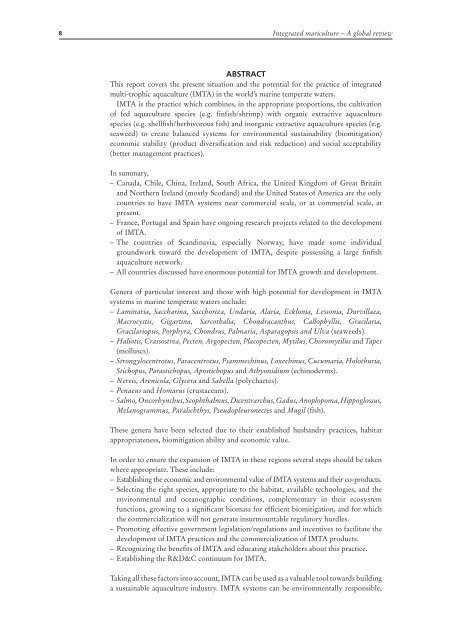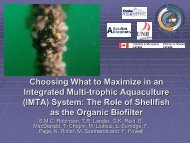Integrated multi-trophic aquaculture (IMTA) in marine temperate waters
Integrated multi-trophic aquaculture (IMTA) in marine temperate waters
Integrated multi-trophic aquaculture (IMTA) in marine temperate waters
Create successful ePaper yourself
Turn your PDF publications into a flip-book with our unique Google optimized e-Paper software.
8<br />
<strong>Integrated</strong> mariculture – A global review<br />
ABSTRACT<br />
This report covers the present situation and the potential for the practice of <strong>in</strong>tegrated<br />
<strong>multi</strong>-<strong>trophic</strong> <strong>aquaculture</strong> (<strong>IMTA</strong>) <strong>in</strong> the world’s mar<strong>in</strong>e <strong>temperate</strong> <strong>waters</strong>.<br />
<strong>IMTA</strong> is the practice which comb<strong>in</strong>es, <strong>in</strong> the appropriate proportions, the cultivation<br />
of fed <strong>aquaculture</strong> species (e.g. f<strong>in</strong>fish/shrimp) with organic extractive <strong>aquaculture</strong><br />
species (e.g. shellfish/herbivorous fish) and <strong>in</strong>organic extractive <strong>aquaculture</strong> species (e.g.<br />
seaweed) to create balanced systems for environmental susta<strong>in</strong>ability (biomitigation)<br />
economic stability (product diversification and risk reduction) and social acceptability<br />
(better management practices).<br />
In summary,<br />
– Canada, Chile, Ch<strong>in</strong>a, Ireland, South Africa, the United K<strong>in</strong>gdom of Great Brita<strong>in</strong><br />
and Northern Ireland (mostly Scotland) and the United States of America are the only<br />
countries to have <strong>IMTA</strong> systems near commercial scale, or at commercial scale, at<br />
present.<br />
– France, Portugal and Spa<strong>in</strong> have ongo<strong>in</strong>g research projects related to the development<br />
of <strong>IMTA</strong>.<br />
– The countries of Scand<strong>in</strong>avia, especially Norway, have made some <strong>in</strong>dividual<br />
groundwork toward the development of <strong>IMTA</strong>, despite possess<strong>in</strong>g a large f<strong>in</strong>fish<br />
<strong>aquaculture</strong> network.<br />
– All countries discussed have enormous potential for <strong>IMTA</strong> growth and development.<br />
Genera of particular <strong>in</strong>terest and those with high potential for development <strong>in</strong> <strong>IMTA</strong><br />
systems <strong>in</strong> mar<strong>in</strong>e <strong>temperate</strong> <strong>waters</strong> <strong>in</strong>clude:<br />
– Lam<strong>in</strong>aria, Sacchar<strong>in</strong>a, Sacchoriza, Undaria, Alaria, Ecklonia, Lessonia, Durvillaea,<br />
Macrocystis, Gigart<strong>in</strong>a, Sarcothalia, Chondracanthus, Callophyllis, Gracilaria,<br />
Gracilariopsis, Porphyra, Chondrus, Palmaria, Asparagopsis and Ulva (seaweeds).<br />
– Haliotis, Crassostrea, Pecten, Argopecten, Placopecten, Mytilus, Choromytilus and Tapes<br />
(molluscs).<br />
– Strongylocentrotus, Paracentrotus, Psammech<strong>in</strong>us, Loxech<strong>in</strong>us, Cucumaria, Holothuria,<br />
Stichopus, Parastichopus, Apostichopus and Athyonidium (ech<strong>in</strong>oderms).<br />
– Nereis, Arenicola, Glycera and Sabella (polychaetes).<br />
– Penaeus and Homarus (crustaceans).<br />
– Salmo, Oncorhynchus, Scophthalmus, Dicentrarchus, Gadus, Anoplopoma, Hippoglossus,<br />
Melanogrammus, Paralichthys, Pseudopleuronectes and Mugil (fish).<br />
These genera have been selected due to their established husbandry practices, habitat<br />
appropriateness, biomitigation ability and economic value.<br />
In order to ensure the expansion of <strong>IMTA</strong> <strong>in</strong> these regions several steps should be taken<br />
where appropriate. These <strong>in</strong>clude:<br />
– Establish<strong>in</strong>g the economic and environmental value of <strong>IMTA</strong> systems and their co-products.<br />
– Select<strong>in</strong>g the right species, appropriate to the habitat, available technologies, and the<br />
environmental and oceanographic conditions, complementary <strong>in</strong> their ecosystem<br />
functions, grow<strong>in</strong>g to a significant biomass for efficient biomitigation, and for which<br />
the commercialization will not generate <strong>in</strong>surmountable regulatory hurdles.<br />
– Promot<strong>in</strong>g effective government legislation/regulations and <strong>in</strong>centives to facilitate the<br />
development of <strong>IMTA</strong> practices and the commercialization of <strong>IMTA</strong> products.<br />
– Recogniz<strong>in</strong>g the benefits of <strong>IMTA</strong> and educat<strong>in</strong>g stakeholders about this practice.<br />
– Establish<strong>in</strong>g the R&D&C cont<strong>in</strong>uum for <strong>IMTA</strong>.<br />
Tak<strong>in</strong>g all these factors <strong>in</strong>to account, <strong>IMTA</strong> can be used as a valuable tool towards build<strong>in</strong>g<br />
a susta<strong>in</strong>able <strong>aquaculture</strong> <strong>in</strong>dustry. <strong>IMTA</strong> systems can be environmentally responsible,



